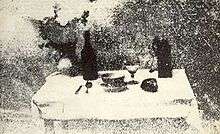Physautotype

The physautotype (in French, physautotypie) was a photographic process, invented by Joseph Nicéphore Niépce and Louis Daguerre[2] in 1832, in which images were produced by the use of lavender oil residue dissolved in alcohol as the photographic agent.[3][4] The solution was coated onto a metal or glass plate and allowed to dry, after which it had a powdery white appearance. The plate was then exposed in a camera obscura for several hours and developed with solvent vapors,[3] which caused the least strongly exposed areas to become proportionally more transparent, creating a photographic image that was positive when viewed against a darker background. The results were reportedly not durable, tending to become entirely transparent over time even if kept in the dark, but additional chemical processing to proportionally etch or darken the underlying surface could be used to "fix" the image.
References
- ↑ Jean-Louis Marignier. "Identification of the image called "La Table Servie" as a physautotype made by Niepce in 1832 - 1833". Université Paris-Sud. Retrieved 20 May 2016.
- ↑ "Daguerre and the Invention of Photography (Physautotype)". Photo-museum.org.
- 1 2 "Art & Architecture Thesaurus, s.v. "physautotypes"". Getty.edu. Retrieved 10 December 2007.
- ↑ Roger Watson, Helen Rappaport (2013). Capturing the Light: A Story of Genius, Rivalry and the Birth of Photography. Pan Macmillan. ISBN 9780230771512.